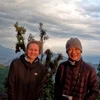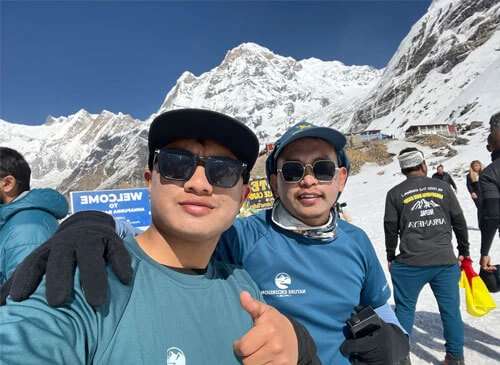Annapurna Circuit Trek with Nar Phu and Tilicho: A Short Introduction
The Annapurna Circuit Trek, the Nar Phu Valley, and the Tilicho Lakes come together with the soul-stirring natural beauty of the Himalayas, landscapes, and cultural experiences. Annapurna Circuit Trek is famous for mesmerizing surrounding views, from lush subtropical forests at lower elevations to desert-like surroundings at high altitude with snowy mountain peaks like Annapurna I and Dhaulagiri. The world’s highest pass, Thorong La Pass, also lies there, which is the highest point of trekking at an elevation of 5,416 meters (17,769 ft).
Tilicho Lake is situated at an elevation of 4,919 meters (16,138 feet) above sea level, sparkling like a blue diamond, surrounded by glaciers and rocky hills. This lake is surrounded by various stunning mountain peaks, including Tilicho Ri, and this trek is part of the Annapurna Circuit Trek. The sparkling lake water and beautiful surroundings make this place a popular trekking destination for photographers and adventure lovers.
The Nar Phu Valley is a hidden gem and a remote trekking destination around Annapurna Circuit. It is one of the less explored trekking routes, and it is where the ancient Tibetan culture thrived. Its remote and rugged terrain, deep gorges, the player flags, traditional-style houses, and the monasteries are the major attractions.
Flora and Fauna in the Annapurna Circuit with Nar Phu and Tilicho
In Annapurna Circuit with Nar Phu and Tilicho Trek, you will be passing through dense forests and a variety of landscapes. Annapurna Conservation Area has endangered unique flora and fauna. Here’s a discussion of what you can expect:
- Flora: The lower regions of this trek have lush and green landscapes, with dense forests of rhododendron, oak, and pine trees. As you ascend, the landscape changes to alpine shrubs and grasses. The Nar Phu region is known for its barren landscapes, with sparse vegetation consisting of bushes and small shrubs. The Tilicho Lake area is mostly rocky, with little vegetation.
- Fauna: The Annapurna region is home to a different species of wildlife. You may spot Himalayan blue sheep, musk deer, and even the elusive snow leopard in the higher altitudes. The region is also home to a variety of birds, including the Himalayan monal, the national bird of Nepal, also known as the Danphe. In the lower regions, you may encounter langur monkeys, barking deer, and a variety of smaller mammals.
What should be your expectations during the Annapurna circuit with Nar Phu and Tilicho?
You will love the trek of the Annapurna Circuit with Nar Phu and Tilicho, as every trekking stop has its own unique charm. Let’s discuss what you can expect during this trek:
- You can expect to see the diverse dramatic landscapes, which change day to day as you ascend to the high altitude. You won’t be bored because you will not see a single day with the same landscapes and surroundings as you’ve seen before, so every day can be a unique day for you.
- You should expect thrilling and challenging passes like Thorong La Pass, the world’s highest pass, standing at an elevation of 5,416 m, and Kang La Pass, standing at an elevation of 5,320 m, but the mesmerizing vistas of the Himalayas make it totally worth trekking.
- You will have the opportunity to go in depth and learn about the ancient Tibetan culture of Nar Phu Valley. You will get to experience interaction with locals, visit old monasteries, and learn about the lifestyle of traditional stone-paved houses.
- You can see the peaceful Tilicho lakes at an elevation of 5,416 meters, as well as other small lakes dotted along the trekking route, which add to the beauty of this trek to the next level.
- You can witness the jaw-dropping views of some of the highest majestic peaks in the world, including Annapurna I, Dhaulagiri, Manaslu, and some other beautiful mountain peaks.
- This trek is a test of mental stamina as well as physical strength, so be well prepared for the challenging yet rewarding trekking experience.
How difficult is the Annapurna Circuit with Nar Phu and Tilicho in 17 days?
Annapurna Circuit with Nar Phu and Tilicho (17 days) is one of the most challenging treks, as it includes two high passes, one is the highest pass in the world, Thorong La Pass, and another pass is Kang La Pass, and trekking through remote areas. There are some factors that can create difficulty while trekking on this route.
You will be crossing the passes of more than 5000 meters during this trek, which carries the chances of altitude sickness, if proper acclimatization is not done. You might have to walk a long time, sometimes 8 to 10 hours a day, so be well prepared for that with good leg strength. The difficult steep ascent and descent, with rocky paths, narrow gorges, and high suspension bridges, can create difficulties while trekking. You can’t predict the weather conditions, as there is a possibility of snow, rain, and cold temperatures, so you should pack full gear.
How difficult are Thorong La Pass and Kang La Pass?
As we know, Thorong La Pass is one of the most difficult passes in the world, as it is also enlisted as the world’s highest pass, at an elevation of 5,416 meters (17,769 feet), and another pass, Kang La Pass, at an elevation of 5,320 meters (17,454 feet), is situated on the Annapurna Circuit with the Nar Phu and Tilicho treks. Chances of having altitude sickness are a real concern over here; the lack of oxygen at this altitude can lead to symptoms like headaches, dizziness, nausea, and fatigue.
The climb to Thorong La Pass and Kang La Pass is several hours of continuous ascents, a challenging climb with steep and uneven paths. You can experience the weather above, like snowstorms, strong winds, and freezing temperatures, which can make the crossing even more difficult, so be prepared with the proper gear. The day you cross these passes can be exhausting, as this can take a few more hours than other days, so you should be mentally and physically fit for this.
A typical day on the Annapurna Circuit Trekking with Nar Phu and Tilicho
A typical day on the Annapurna Circuit trekking with Nar Phu and Tilicho starts with waking up early in the morning, around 6 a.m. We freshen up and have breakfast, then pack your backpack and start to trek. Usually, the morning trek is the longest; we walk for around 4 to 5 hours, then take a lunch break at a lodge or teahouse. We enjoy a good meal there, and we take a rest for an hour or more.
We continue trekking after having a short break for lunch; we walk for around 2 to 3 hours. After this, we arrive at our destination for the day and then check in, freshen up, and relax. After that, we go explore the nearby village or surrounding area, interact with locals, and learn about their cultures and ways of living. We enjoy a warm dinner in the evening at the teahouse and relax, play cards, and talk with other trekkers. After that, we go to bed and rest well for the next day’s trek.
A typical day at Thorong La Pass and Kang La Pass
In these two days, we wake up early, around 4 to 5 a.m., and start our trek early to avoid strong winds later in the day. We will carry some food and energy bars, pack up in the dark, and eat along the way while resting for a few minutes. We pass through the steep ascent under the light of your headlamp, and the path is rugged and rocky, with the air becoming thinner as you ascend to the higher elevation.
Both passes can be covered with snow, with distant mountain peaks glowing in the morning light. The altitude makes each step challenging, so it is important to take frequent short breaks as necessary to catch your breath. After we reach the Thorong La Pass with the celebration of achievement, we descend down to the Muktinath. Once you reach Kang La Pass, we descend down to the Ngawal village after taking some pictures and enjoying ourselves.
Why should you prioritize Nature Excursion Pvt. Ltd. for Annapurna Circuit with Nar Phu and Tilicho for 17 days?
We, the Nature Excursion family, care for our guests, as we believe in “Atithi Dewo Bhawa,” which means guests are like gods. We prioritize your safety and well-being, making sure that you have had a great time with us during the trek. You don’t need to be worried while you are here in our country with us.
We will provide you with a well-experienced guide to look after your problems and trekking route. They are fluent in English, and can help you communicate with locals as well. The guide will be guiding you throughout your journey in the Himalayas.
We can provide you with these things:
- Free pickup and drop-off service from and to Tribhuvan International Airport.
- Company t-shirt.
- Down jacket, duffel bags, and sleeping bags, which you have to return after the trek.
- Mountain guides have immense Himalayan experience.
- Helicopter evacuation and medical treatment while needed (from your travel insurance company’s expenses).
- Store your extra luggage in our office.
- a first-aid kit and an oximeter for your safety.
- Certificate of appreciation after the completion of the trek.
- Farewell meal for you after the end of this trip.




.webp)
.webp)
.webp)
.webp)
.webp)
.webp)
.webp)
.webp)



